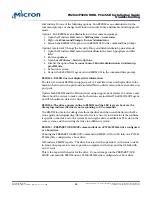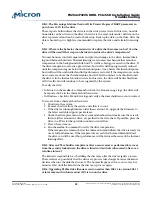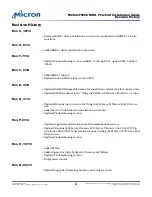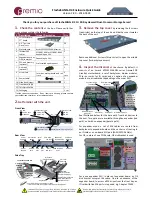
ESX5.5i and later:
1. Enable the Secure Shell (SSH) option in ESX 5.5i kernel.
2. Open an SSH session with the host.
3. Enter the following command to obtain the name of the Micron drive:
esxcli storage core device list | grep t10*
One or more devices should appear. The Micron drive name starts with t10.ATA*.
4. Copy the entire device name string.
5. Enter the following command to display Micron drive values:
esxcli storage core device list -d <drive_name_string>
6. Enter the following command to change the queue depth value (the queue depth
value appears under No of outstanding IOs with competing worlds:):
esxcli storage core device set -d <drive_name_string> -O 255
7. Enter the following command to verify the new setting:
esxcli storage core device list -d <drive_name_string>
VM-3: How do I configure the PVSCSI adapter's settings in Windows?
Change the disk queue depth for a paravirtualized SCSI adapter:
1. Open the Windows Registry Editor (
Start
>
Run
>
regedit
).
2. Navigate to the following path; if the end of the path is not created, create the last
keys:
HKEY_LOCAL_MACHINE\SYSTEM\CurrentControlSet\Services
3. In the Device Key, create or modify a string value named
DriverParameter.
4. Set the value data of DriverParameter to
MaxQueueDepth=255
. Do not remove the
quotation marks from the MaxQueueDepth value.
5. Reboot the guest operating system.
Note:
ESX LUN Queue Depth (default setting is 30 on Emulex and 32 on QLogic) needs
to be changed if you want to go beyond 64 with the PVSCSI drive.
VM-4: Where does the device name t10.ATA_________### come from?
The P320h/P420m drive contains an ATA interface for management commands. The
SCSI driver translates the SCSI inquiry (and other) requests to the appropriate ATA
command. This is not true for I/O READ/WRITE commands which use a proprietary ex-
tension to AHCI and the NCQ command protocol to reach the 256 queue depth (255
with 1 reserved for internal commands).
The SCSI driver supports the SAT-3 specification which uses the t10 format for device
identification. VMware displays this format as the device identifier.
VM-5: Is raw device mapping (RDM) supported?
VMware does not support RDM of local storage; however, numerous online articles de-
scribe how to perform manual mapping of any local storage device to RDM, both physi-
cal and virtual RDM.
In performance tests run at Micron, an average improvement in latency of 5µs was seen
over standard VMDK mapping.
P420m/P320h HHHL PCIe SSD Installation Guide
Troubleshooting
PDF: 09005aef8497e00a
P420m_P320h_HHHL_installation_guide.pdf - Rev. V 12/14 EN
40
Micron Technology, Inc. reserves the right to change products or specifications without notice.
©
2012 Micron Technology, Inc. All rights reserved.
















































